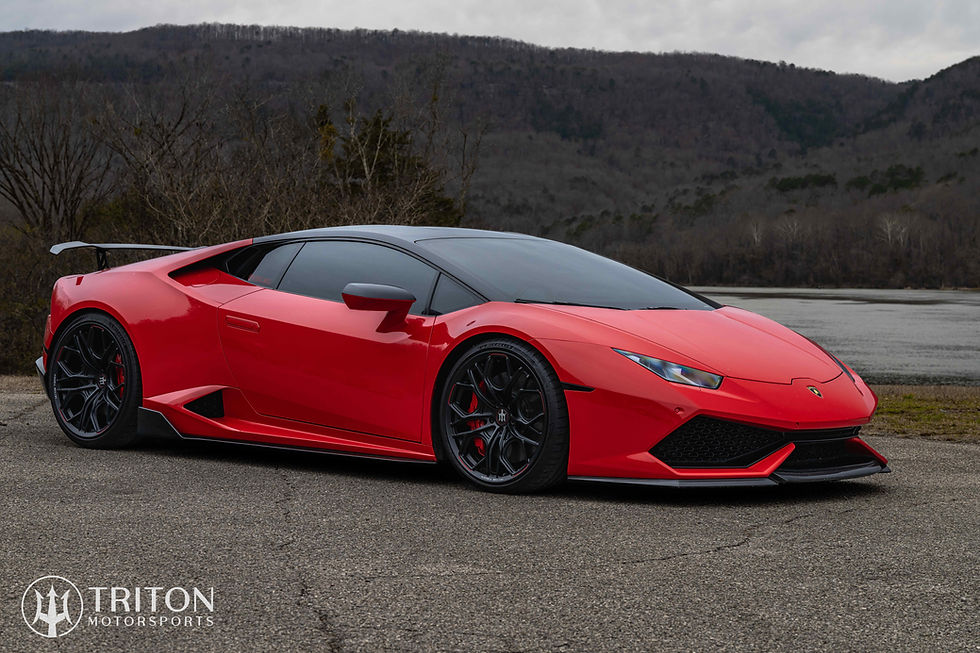Cast vs. Flow-Formed vs. Forged Wheels: Spot the Difference and Choose the Right Performance Upgrade
- Triton Motorsports

- Sep 1
- 3 min read
In the aftermarket wheel world, flashy marketing claims—terms like “flow-forged,” “rotary-forged,” and “cross-forged”—can confuse buyers. Many of those wheels are still essentially cast, but with a touch of mechanical reworking to make them sound more advanced.
If you're shopping for wheels and want real performance without the buzzwords, here’s your definitive comparison of Cast, Flow‑Formed, and Forged wheels—so you know exactly what you're paying for.
1. Cast Wheels: Affordable—but Limited in Performance
What Are They? Cast wheels are made by pouring molten aluminum into molds. As the alloy cools, it solidifies into shape.
Advantages:
Cost-effective and widely available
Offers a vast range of styles and finishes
Lightweight compared to steel
Drawbacks:
Porosity: Mold imperfections can introduce structural inconsistencies.
Heavier design required: Manufacturers must compensate for weak spots by using more material, increasing weight.
Crack-prone under stress: Especially in high-performance settings.
Cast wheels work for daily-driven vehicles. But if you demand performance or frequent track sessions, they’re the weakest link.
2. Flow-Formed Wheels: Marketing Hype Often Masks Reality
What Are They? These start with a cast wheel that's then spun while heated. Rollers press and stretch the barrel section, improving material density and strength.
Common Labels: You’ll see “flow-forged,” “rotary-forged,” or “spun-forged”—but these terms are just repackaged flow-formed wording.
Advantages:
Slightly stronger and lighter than cast wheels.
Better grain structure in the barrel.
Offers some structural improvement at a moderate price premium.
Drawbacks:
Still starts as a cast wheel; only the barrel is enhanced. The center remains cast.
Not as strong or light as fully forged wheels
Price approaches forged territory, but without the full benefits
While flow-formed wheels offer a step up, they’re still a mid-tier compromise, not full performance upgrades.
3. Forged Wheels: The Gold Standard for Performance
What Are They? Forged wheels are created from a solid billet of aluminum, shaped under high pressure, then CNC machined to precise specifications. The process produces a denser, lighter, and stronger wheel.

Advantages:
Superior strength-to-weight ratio—up to 30% lighter than same-size cast wheels
No porosity or weak spots
Better impact resistance—bends instead of cracks under stress
Fully customizable: offsets, bolt patterns, barrel widths, finishes, and brake clearance tailored to your exact car
Drawbacks:
The most expensive manufacturing process due to costly materials and machining
Requires skilled craftsmanship and longer lead times
However, for serious performance drivers, motorsport applications, and enthusiasts who want precision fitment and minimal unsprung mass, forged wheels are unmatched.
4. Why “Flow-Formed” is Often Just a Gimmick
Many brands use buzzwords like “flow-forged” to sound high-end—without delivering forged-level strength.
Enthusiast communities note that flow-formed wheels have a barrel strength close to a forged barrel but retain cast centers, making them stronger than cast, but not forged.
Marketing labels that hint at forging often trail logic; always ask for the manufacturing method, not just the label.
If a wheel costs nearly as much as a forged wheel but claims "flow-forged" status, it's likely just a polished cast wheel with minimal structural enhancement.
5. Real Road & Track Use — What You’ll Feel
Cast: heavy, flexes under load, prone to crack on big impacts.
Flow-Formed: lighter, slightly stronger, but still not ideal for repeated track abuse.
Forged: ultra-light, rigid, handles heat and impact cycles—even in high-G cornering or braking
And for aesthetics: forge machining allows for intricate spokes, stepped lips, and bespoke finishes that flow‑formed or cast processes can’t match.
6. Why Investing in Custom Forged Wheels Pays Off
True Performance Gains: Forged wheels drop rotational and unsprung mass—improving acceleration, braking, and steering response.
Perfect Fitment: Custom forged wheels ensure proper offsets, PCDs, and caliper clearance for your specific vehicle.
Durability: You avoid the brittleness of cast and the partial reinforcement of flow-formed designs.
Longevity & Aesthetics: Precision finishes and structural integrity stay intact under real-world abuse.
—
7. Summary Table: Cast vs. Flow-Formed vs. Forged
Feature | Cast Wheels | Flow-Formed Wheels | Fully Forged Wheels |
Manufacturing Process | Mold casting | Cast + spun barrel forming | Forged billet + CNC |
Strength & Durability | Low | Moderate | Highest |
Weight | Heaviest | Lighter than cast | Lightest |
Price | Cheapest | Mid-range | Highest |
Customization Options | High | Limited | Extensive |
Best For | Budget street use | Moderate performance | Track-level/performance use |
Marketing Clarity | Transparent | Often deceptive labeling | Clear and honest |
Conclusion — Avoid the Marketing Circus
Flow-formed wheels may look like a bargain between cast and forged, but they’re often over-sold as forged. For everyday use, they’re durable enough—but for performance, safety, and long-term value, only forged wheels deliver real substance.
If your ride is a high-performance vehicle, driven hard or raced, you deserve more than marketing spin. You deserve precision, strength, and performance. You deserve forged wheels, custom-designed for your application and built to last.




Comments